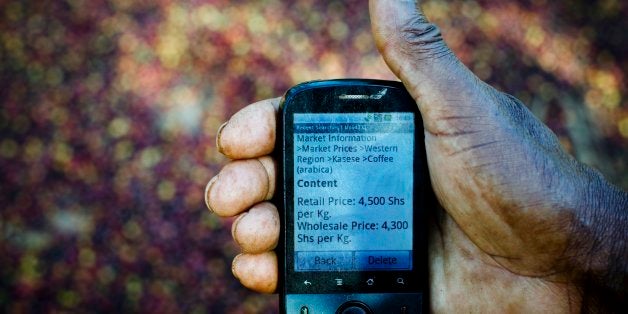
Four-fifths of the developing world's food is produced by its most vulnerable households. These farmers often subsist on meager earnings derived from small, depleted plots that are far-removed from markets. Despite their often singular devotion to food production, one in eight is undernourished. As increasingly erratic and extreme climate changes disproportionately affect these under-resourced farmers, food insecurity is projected to worsen dramatically. By 2050, the world's population will increase by 2 billion, causing demand and food prices to spike -- yet food production is projected to decline significantly in every region.
Now imagine if farmers, industry, government, universities and research institutions, NGOs, and donors rose above their individual interests and collaborated to promote sustainable production and consumption, and by extension reduce hunger and food insecurity? Imagine if they took a holistic approach to investing resources that not only increased agricultural productivity, but also household income and farmers' resilience to life's uncertainties? The benefits could include better health, increased educational opportunities, an improved environment, increased rural development, and inclusive economic growth. This level of cooperation would require each stakeholder to apply the best known strategies for the greatest possible good.
This may seem like a no-brainer, but we in the development community have yet to adopt this approach in a concerted way. This is what makes the Sustainable Development Goals (SDGs) so promising. Unlike the Millennium Development Goals that preceded them, the SDG agenda -- by which public, private, and civil-society actors will steward their resources and measure their results over the next 15 years -- is finally integrated and inclusive. In fact, it is underpinned by Goal 17, a new paradigm for partnerships that promotes collaboration, efficiency, transparency, and accountability. While we will all benefit, those who stand to gain the most -- the 1.2 billion people currently living in extreme poverty -- must play a central role. There is much talk around how a data revolution can enable this.
Grameen Foundation has long taken an inclusive approach to poverty alleviation. Though we focus on financial inclusion, agriculture, and health, we realized early on the importance of driving integration across these sectors to achieve maximum impact. We also learned the promise of digital to enable partners to reach across geographies to share and work from the same real-time data, hold each other accountable, and improve our knowledge and decision-making. For example, in 2009 we built a digital platform with the power to link farmers to critical information about farming, land and water resource management, weather, market prices, and nutrition. Keeping the platform relevant required us to work with organizations like the Food and Agriculture Organization (FAO), Starbucks, and numerous governmental bodies to aggregate and disburse up-to-date content on farming techniques and emerging technologies, as well as with poor, rural households to collect reams of data on their lives. This has given us and our partners a much deeper level of visibility into the needs of poor farmers than was previously available in the markets in which we work.
Today, banks use the same platform, the same data, to analyze farm businesses and assess credit risk remotely. This allows lenders -- who previously were unwilling to invest in traveling long distances to visit and assess low-volume, high-risk farmers -- to reduce their transaction costs, while increasing the likelihood that more farmers could qualify for loans. Cooperatives use the platform to identify farmers who will never earn enough profits to move out of poverty because the size of land is too small to support their family. Rather than waste time and resources trying to boost their productivity, they can instead connect these farmers to programs that will better serve their needs. Agencies can use the platform to monitor for projected pest outbreaks and trigger early warnings that can stem widespread damage. And agribusinesses use the platform to identify and source produce from farmers in their regions, enabling farmers to become reliable suppliers to markets that previously were invisible to them.
With one common platform, farmers have become better-resourced, more bankable, and central to markets, while governments, the private sector, and development organizations are able to make data-based decisions, deliver better services based on evidence of demand, and deepen their reach to poor households.
Goal 17 calls for a similar model, with targets emphasizing technology, data, and knowledge-sharing. We're excited about the power of digital to make this possible. Grameen Foundation, for one, is committed to applying its country-level experience and knowledge, and elevating its technologies and ecosystem approach, to a global level in pursuit of the SDGs. With the SDGs, the development community has already come together behind a common vision and a common approach. Next, by linking SDG actors together through common resources -- core digital infrastructure where data is shared with complete transparency and its consumers are helped along by a open supply of relevant analytical tools -- then everyone, from the poorest among us to the top policymakers and most competitive industry agents, can finally come together for our common good.
This post is part of a series produced by The Huffington Post, "What's Working: Sustainable Development Goals," in conjunction with the United Nations' Sustainable Development Goals (SDGs). The proposed set of milestones will be the subject of discussion at the UN General Assembly meeting on Sept. 25-27, 2015 in New York. The goals, which will replace the UN's Millennium Development Goals (2000-2015), cover 17 key areas of development -- including poverty, hunger, health, education, and gender equality, among many others. As part of The Huffington Post's commitment to solutions-oriented journalism, this What's Working SDG blog series will focus on one goal every weekday in September. This post addresses Goal 17.